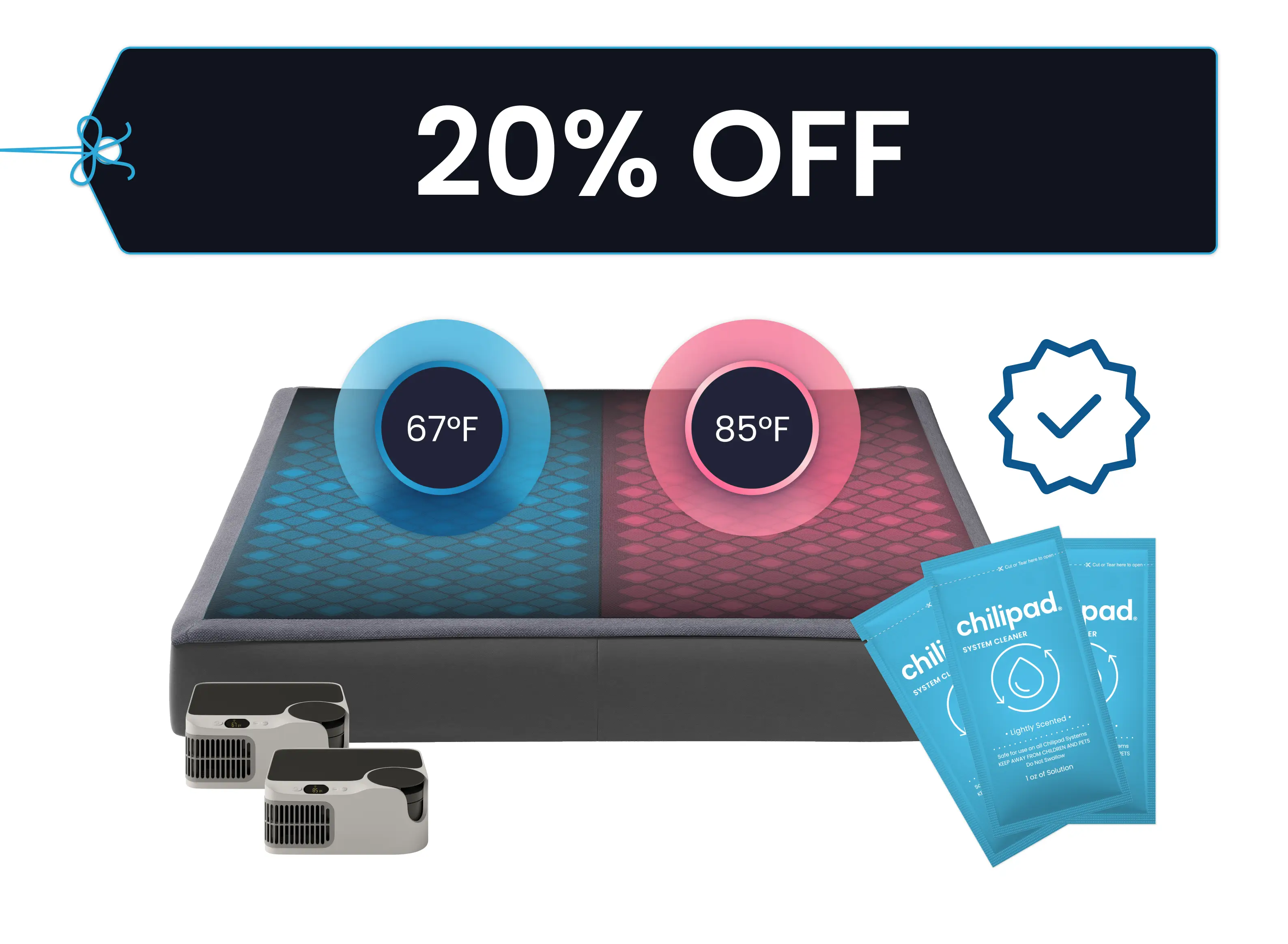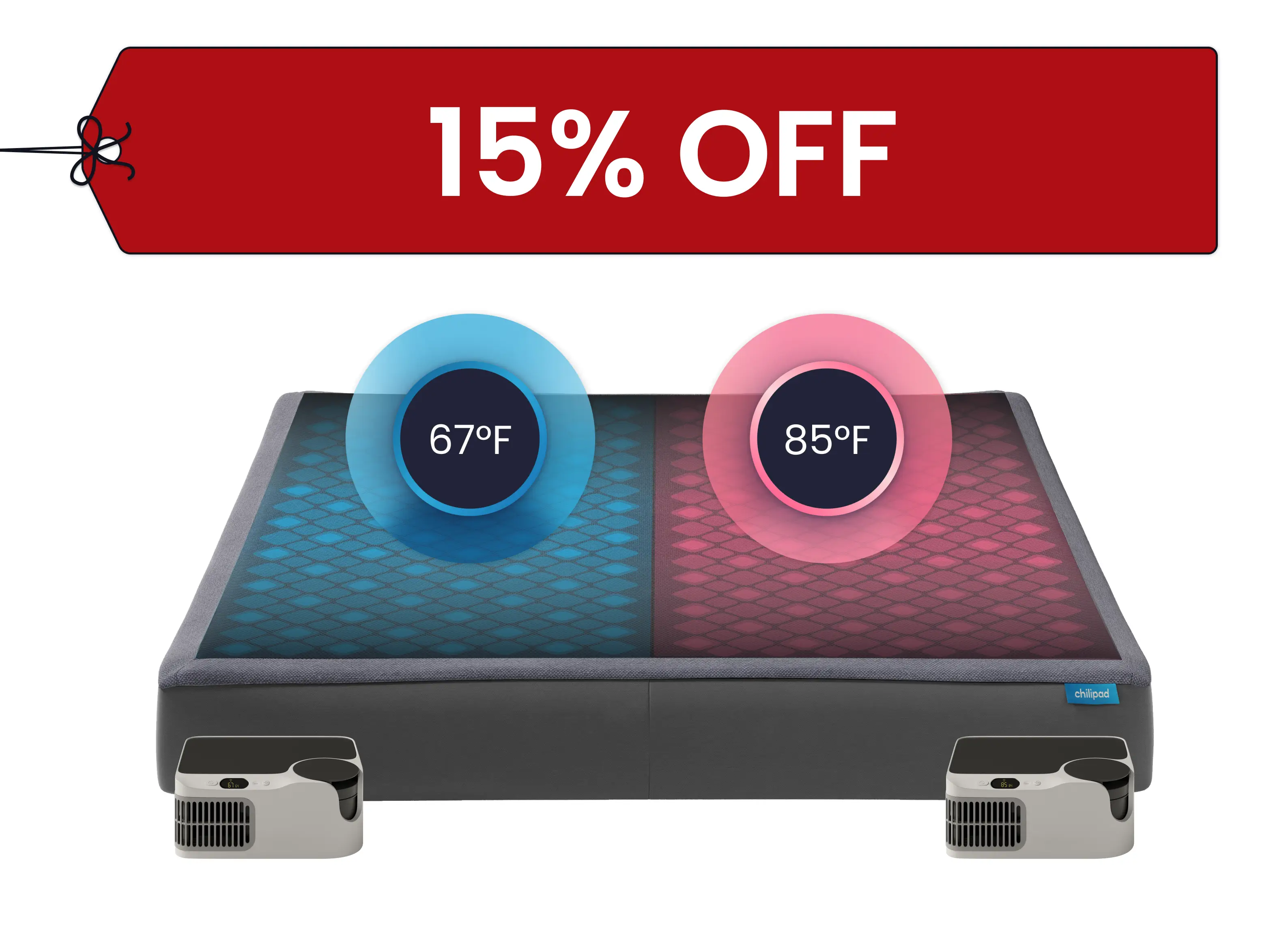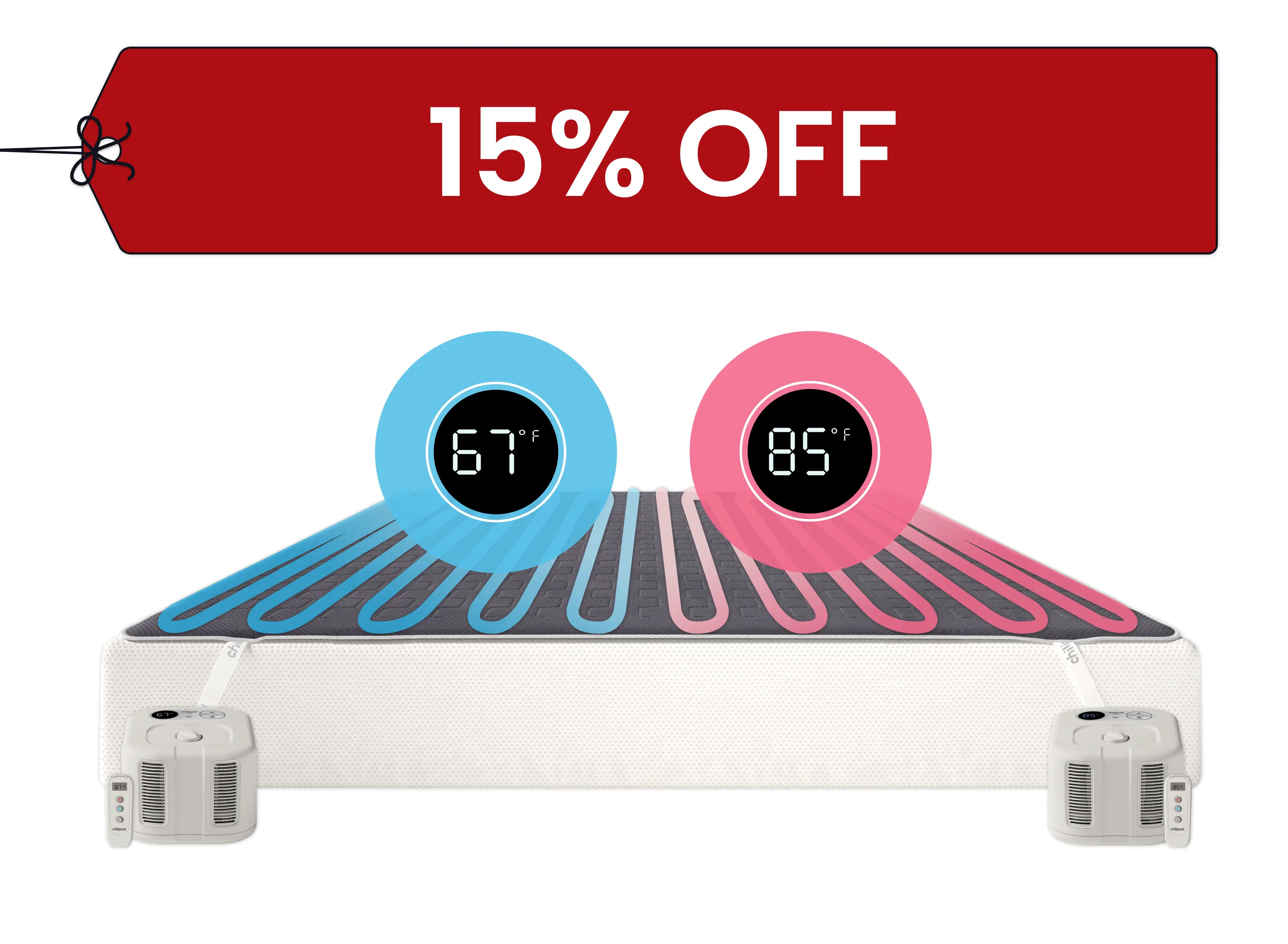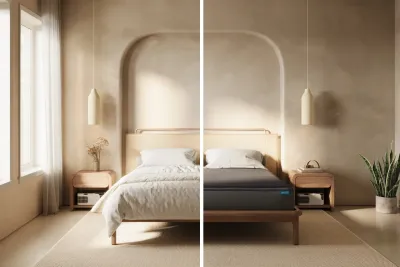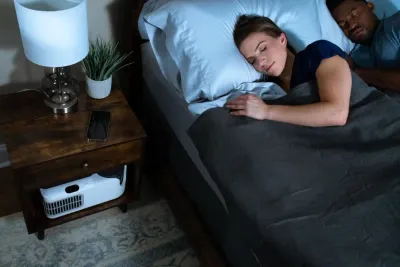How to Cool Down Your Memory Foam Mattress for Better Sleep
Chilipad Editorial Team • May 27, 2025
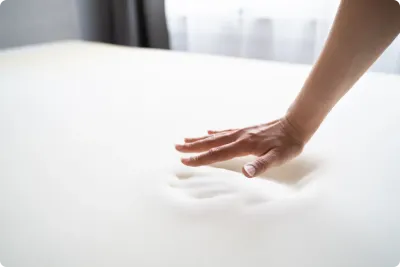
Key Takeaways
- Heat Buildup: Memory foam traps body heat by design—great for pressure relief, not so great for cooling.
- Simple Fixes: Try breathable sheets, moisture-wicking pajamas, or opening a window for natural airflow.
- Mattress Topper Upgrade: Adding a cooling mattress topper (like Chilipad Dock Pro) can majorly improve nighttime comfort.
- Sleep Boost: A cooler mattress isn’t just about comfort—it can help improve your sleep quality and recovery.
You love the contouring comfort of your memory foam mattress. That feeling of sinking into a cloud, pressure points melting away—it’s sleep perfection—until it’s not.
Is your memory foam mattress too hot? You're not alone if you wake up hot and sweaty and feel trapped in a personal sauna. Many people who sleep hot experience this issue due to memory foam density. The very density that makes memory foam so amazing can also turn it into a heat trap.
Don’t sweat it — literally. Your mattress isn’t done for. Memory foam is awesome for pressure relief, but it’s also famous for trapping heat, which is why so many hot sleepers end up searching for a cooling mattress solution or sleep technology that actually keeps things steady through the night.
We’re here to help you shift your setup from sweltering to calm. With a few smart tweaks, you can cut down heat retention and reclaim the cool bed you’ve been missing. We’ll give you the tools and knowledge on how to prevent heat retention in memory foam mattresses to reclaim your cool bed. Let’s make your memory foam mattress the cool, comfortable bed you deserve.
Save Up to 20% - Cool Down Your Memory Foam Mattress
If you’re tired of sleeping hot and waking up overheated, try the Chilipad. Cool down even a heat-trapping foam mattress—or warm it up—anywhere from 55°F to 115°F.
Cooling Mattress Topper
Memory foam mattresses are comfortable but often hold onto body heat, leaving you hot at night. A cooling mattress topper fits over your current mattress and quickly helps solve this by creating a cooler surface that balances out the heat-trapping nature of foam.
Depending on the technology, some cooling toppers use passive materials while others use active cooling systems, both designed to keep you more comfortable and improve sleep quality.

Chilipad Cooling Mattress Topper
For an advanced way to keep your memory foam mattress cool, try the Chilipad Dock Pro. It's the best cooling mattress topper that circulates chilled water as low as 55ºF through the topper, letting you customize temperature for the whole bed or just one side.
Our cooling mattress topper gives you programmable sleep temperature and steady cooling that memory foam can’t offer on its own. This kind of cooling mattress technology lets you dial in the exact degree you want.
The Chilipad fits any mattress size, twin through California king—and works with adjustable or split beds, so you keep the mattress you love but add personalized cooling. There is no need to purchase a new mattress. While memory foam still traps heat, using the Chilipad’s water-cooling technology significantly improves overall bed temperature for a better night’s sleep.
Bed Foundation and Bed Frames
The type of bed frame you use can impact how hot your mattress feels at night. A slatted bed base consists of wooden or metal slats spaced evenly apart, allowing air to flow beneath and around your mattress. This increased airflow helps dissipate heat and moisture that can get trapped in memory foam, preventing overheating.
A solid platform base or placing your mattress directly on the floor can hinder ventilation, leading to heat buildup. Switching to a slatted bed base can foster a cooler and more breathable sleep environment, resulting in a better night's sleep. It's best to avoid placing your memory foam mattress directly on the floor for sleeping.
Related Blog: Interested in understanding the differences between Chilipad and Eight Sleep cooling bed systems? Explore how each solution approaches temperature regulation, comfort, and features for better sleep.
Cooling Sheets
Choosing the right bedding can significantly improve your comfort while sleeping on a foam mattress. Opt for lightweight, moisture-wicking sheets made from breathable materials like cotton, bamboo, linen, or Tencel, which are cool to the touch and promote airflow.
These natural fabrics promote airflow, allowing heat to escape rather than get trapped against your body, helping you stay cooler throughout the night.
Unlike synthetic materials such as Polyester and popular Microfiber, which tend to retain heat and moisture, natural fibers enhance ventilation and create a more refreshing sleep environment. For optimal comfort, choose high-quality cotton with a thread count between 200 and 350 or linen, which is naturally breathable and moisture-wicking.
Switching to cool, breathable bedding can improve airflow, reduce heat buildup, and enjoy a more restful night’s sleep.
Adjust Your Bedroom Temperature
Make your bedroom cooler as the temperature plays a critical role in how well—and how cool—you sleep, especially on a memory foam mattress bed. Experts recommend setting your thermostat between 60-67°F (15-19°C) for the best sleep comfort, as cooler temperatures help signal your body that it’s time to rest.
Options can include using a ceiling fan or oscillating fan can help push hot air away from your body, while an open window (if weather permits) can let in fresh, cool air. A cooler bedroom environment helps counteract the heat-retaining properties of memory foam, creating a more comfortable sleep experience.
Consider Your Sleepwear
The clothing you wear to bed can greatly influence your body temperature and overall sleep comfort. For a cooler night’s rest, opt for lightweight, breathable fabrics like cotton or thin wool, which allow for better airflow and help wick away moisture.
If you tend to overheat at night, you might find that sleeping in just your underwear—or even going without sleepwear altogether—provides the most comfort and temperature regulation. Choosing the right sleepwear can make a noticeable difference in how well you sleep, especially on a heat-retaining mattress.
Cool Comfort of Cooling Pillows
Our heads and necks are particularly sensitive to temperature changes, and a hot pillow can disrupt sleep without our knowledge. Fortunately, there are plenty of cooling pillow options that are worth the investment.
Make sure the pillow is lightweight and breathable, and contains soft fabrics like cotton or linen offer natural cooling, while fills such as latex, buckwheat, down alternative, or shredded foam generally outperform solid memory foam in terms of heat dissipation.
Some incorporate advanced cooling technologies, such as cooling panels, cooling gel memory foam, or copper-infused materials, to further enhance temperature regulation. This allows your head to stay nice and cool—no need to flip your pillow throughout the night!
Evaluate Mattress Size
The size of your mattress can significantly affect how cool you sleep, especially if you share your bed with a partner. A smaller mattress, such as a full or queen, means less space between you and your partner, which can lead to increased body heat retention.
Upgrading to a larger mattress, like a King or California King, provides more room to spread out. This reduces direct contact and allows for more space between you and your partner.
Remember: If upgrading your mattress isn’t an option, consider using a bed cooling system, like the Chilipad Dock Pro or Cube, to regulate individual sleep temperatures without affecting your partner. If you're not sure which is the best system, find out which is right for you.
Why Memory Foam Mattress Retains Heat?
Memory foam mattresses are known for shaping perfectly to your body, offering great support and pressure relief. But this same closeness also causes them to trap heat, making the mattress feel warm and sometimes uncomfortable, which can disrupt your sleep.
This happens because memory foam is dense and holds onto your body heat instead of letting it escape. Unlike normal mattresses with coils or natural materials, memory foam doesn’t allow much air circulation, so heat builds up around you as you sleep.
Understanding this helps explain why memory foam beds can feel hot and what you can do to sleep cooler.
What Causes Heat Retention in Memory Foam Mattresses
Memory foam mattresses fit your body closely, giving great support and pressure relief. But this close fit also traps your body heat, making the mattress feel warm and sometimes uncomfortable.
This happens because memory foam is dense and has a tight cell structure that absorbs and holds heat instead of letting it escape. Unlike mattresses with coils or breathable natural materials, memory foam limits airflow, so heat builds up around you as you sleep. Knowing this helps explain why memory foam beds can get hot and what you can do to stay cooler at night.
How Heat Retention Affects Sleep Quality
Heat trapped by memory foam mattresses can make it harder to fall asleep and stay asleep, leading to restless nights and daytime tiredness. A warm sleeping surface can cause discomfort and night sweats, disrupting your rest.
For those with sleep disorders like insomnia or sleep apnea, heat retention can make symptoms worse and reduce your quality of sleep even more. Staying cool throughout the night is key to getting restful, uninterrupted sleep.
Why It’s Important to Address Heat Retention
Reducing heat retention in memory foam mattresses is important when it comes to improving your sleep quality. Creating a cooler, more comfortable surface helps you fall asleep faster and stay asleep longer.
Below are a few of our favorite tips to help lower heat buildup and make your memory foam mattress feel cooler.
Understanding Active Cooling vs. Passive Cooling
Active and passive cooling differ primarily in their energy use and how they remove heat
Passive Cooling
Passive cooling refers to materials or surfaces that initially feel cool to the touch but gradually lose their cooling effect over time. For example, a surface may stay cool for about 10 minutes, but once exposed to a 98.3-degree body for an extended period—such as two hours—it absorbs heat and no longer provides a cooling sensation.
Unlike active cooling systems that continuously regulate temperature, passive cooling relies on initial thermal dissipation, making it ineffective for long-term temperature control.
Active Cooling
Active cooling utilizes powered devices such as fans and pumps to forcibly transfer heat from one location to another.
For instance, a cooling mattress topper that circulates chilled water or air is a prime example of active cooling, requiring electrical power to maintain its temperature, whereas a gel-infused memory foam topper that simply absorbs heat would be considered passive.
How Does an Active Cooling Topper Like a Chilipad Work?
The Chilipad mattress pad uses a simple heat transfer process to keep your mattress cool all night.
- Heat Absorption: Your body naturally produces heat while you sleep. The Chilipad's water-filled mattress topper absorbs this heat from your body.
- Heat Transfer: The warmed water is then pumped away from the bed to a control unit.
- Heat Exchange: Inside the control unit, the heat from the water is transferred to the air and released outside the unit, cooling the water down.
- Continuous Cycle: Cooled water is continuously circulated back through the mattress topper, maintaining a consistent, comfortable temperature all night long.
This cycle keeps your bed at the temperature you want without letting heat build up.
Final Thought
Do you love your memory foam but hate the heat? You’re not alone. There are plenty of easy ways to turn your mattress from a sauna into something you can actually sleep on — think cooling toppers (like the Chilipad), breathable sheets, and slatted bed frames for better airflow. Even simple tweaks such as dropping your room temperature or switching up your sleepwear can make a noticeable difference. Cooling pillows help too, and if you’ve got the space, a larger mattress gives your body more room to release heat.
You don’t have to pick between comfort and coolness. With a few smart adjustments, your memory foam can finally feel as good as it was meant to. And if your mattress still cranks up the heat, an advanced bed cooling system gives you precise temperature control and steady comfort so you can actually manage sleep temperature instead of battling it every night.
Frequently asked questions
Is the Chilipad Compatible with Memory Foam Mattresses?
Yes—memory foam meets its match. The Chilipad is absolutely compatible with memory foam mattresses. It fits on any size or type of memory foam mattress and sits right on top of your bed, under your fitted sheet, delivering consistent cooling or warming without messing with the contouring comfort you love.
With this advanced bed cooling system, you get steady, targeted relief from heat buildup that memory foam is known for. It also gives you programmable sleep temperature control, making it easy to manage sleep temperature and address night sweats without touching the thermostat.
Why Does Memory Foam Retain Heat?
Memory foam is basically a heat trap in disguise. It’s made from viscoelastic polyurethane, a dense material designed to contour to your body. That deep, hugging support feels great—but it comes at a cost. The foam absorbs your body heat to soften and mold around you, but its dense structure doesn't allow much airflow. The heat gets trapped, and things can get hot fast.
Do Cooling Mattress Toppers Really Work?
Yes—especially those with active cooling tech, like the Chilipad and its water-circulation system. Passive cooling toppers can take the edge off, but an advanced bed cooling system gives you steady, predictable comfort all night. Active cooling is simply better at managing sleep temperature and keeping heat from building up under you, which makes it a stronger cooling mattress solution for anyone dealing with night sweats or a mattress that traps heat.
If you want the full breakdown, check out our blog. It explains how cooling mattress technology actually works and whether a cooling mattress topper works for your sleep goals.
How Can I Cool Down My Memory Foam Mattress?
To cool down your memory foam mattress, use breathable sheets, a cooling mattress topper, and a fan or AC to boost airflow. Slatted bed frames help too.
- Improve mattress airflow: Slatted bed frame: Ensure your mattress is on a slatted bed frame rather than a solid platform or directly on the floor. Slats allow air to circulate underneath, preventing heat buildup.
- Elevate Your Bed: A bed frame that lifts the mattress off the ground further promotes airflow.
- Cooling Mattress Toppers and Pads: These are a fantastic solution. They can keep your foam mattress cooler for a better sleep.
- Adjust Your Sleep Attire: Wear breathable pajamas: Opt for loose-fitting sleepwear made from natural fibers like cotton or bamboo.
- Advanced Cooling Solutions: Chilipad, circulate temperature-controlled water through a pad placed on top of your mattress, offering precise cooling.

